英语微格教学课时教案
- 格式:doc
- 大小:50.50 KB
- 文档页数:5
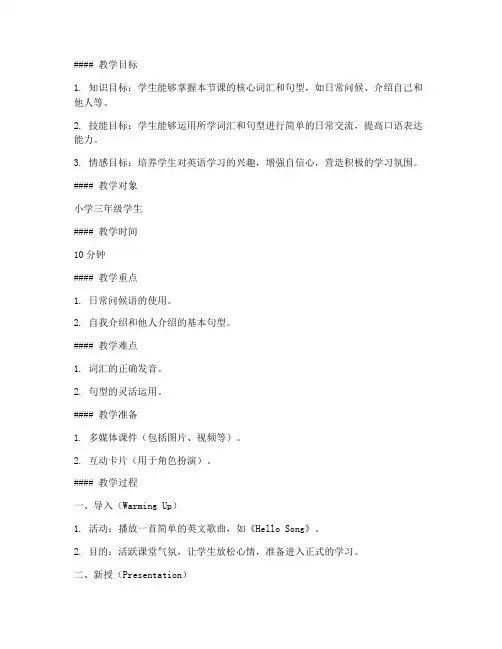
#### 教学目标1. 知识目标:学生能够掌握本节课的核心词汇和句型,如日常问候、介绍自己和他人等。
2. 技能目标:学生能够运用所学词汇和句型进行简单的日常交流,提高口语表达能力。
3. 情感目标:培养学生对英语学习的兴趣,增强自信心,营造积极的学习氛围。
#### 教学对象小学三年级学生#### 教学时间10分钟#### 教学重点1. 日常问候语的使用。
2. 自我介绍和他人介绍的基本句型。
#### 教学难点1. 词汇的正确发音。
2. 句型的灵活运用。
#### 教学准备1. 多媒体课件(包括图片、视频等)。
2. 互动卡片(用于角色扮演)。
#### 教学过程一、导入(Warming Up)1. 活动:播放一首简单的英文歌曲,如《Hello Song》。
2. 目的:活跃课堂气氛,让学生放松心情,准备进入正式的学习。
二、新授(Presentation)1. 活动:展示多媒体课件,呈现核心词汇和句型。
2. 内容:- 核心词汇:hello, good morning, nice to meet you, my name is... - 核心句型:How ar e you? I’m fine, thank you. And you?3. 目的:通过视觉和听觉的结合,帮助学生直观地学习新知识。
三、练习(Practice)1. 活动:分组进行角色扮演,模拟日常问候和自我介绍的场景。
2. 内容:- 学生A:How are you?- 学生B:I’m fine, thank you. And you?- 学生A:My name is... I’m from...3. 目的:通过实际操作,让学生在轻松愉快的氛围中练习所学内容。
四、巩固(Consolidation)1. 活动:分发互动卡片,让学生根据卡片上的提示进行对话。
2. 内容:- 卡片1:My name is...- 卡片2:I’m from...- 卡片3:How are you?3. 目的:巩固所学知识,提高学生的口语表达能力。
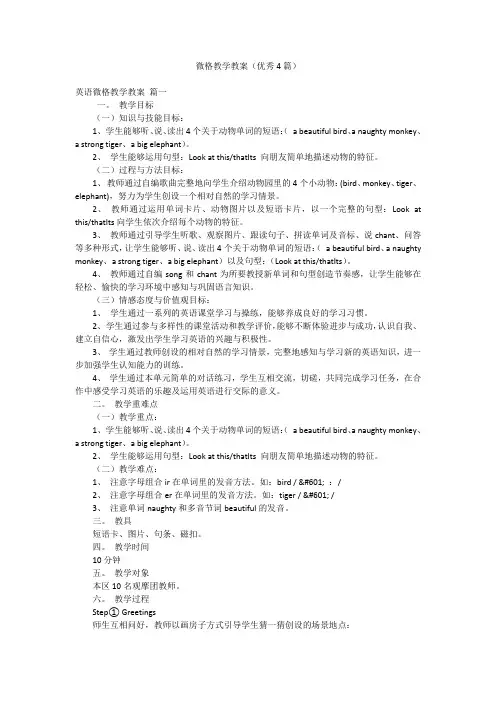
微格教学教案(优秀4篇)英语微格教学教案篇一一。
教学目标(一)知识与技能目标:1、学生能够听、说、读出4个关于动物单词的短语:(a beautiful bird、a naughty monkey、a strong tiger、a big elephant)。
2、学生能够运用句型:Look at this/thatIts 向朋友简单地描述动物的特征。
(二)过程与方法目标:1、教师通过自编歌曲完整地向学生介绍动物园里的4个小动物:(bird、monkey、tiger、elephant),努力为学生创设一个相对自然的学习情景。
2、教师通过运用单词卡片、动物图片以及短语卡片,以一个完整的句型:Look at this/thatIts向学生依次介绍每个动物的特征。
3、教师通过引导学生听歌、观察图片、跟读句子、拼读单词及音标、说chant、问答等多种形式,让学生能够听、说、读出4个关于动物单词的短语:( a beautiful bird、a naughty monkey、a strong tiger、a big elephant)以及句型:(Look at this/thatIts)。
4、教师通过自编song和chant为所要教授新单词和句型创造节奏感,让学生能够在轻松、愉快的学习环境中感知与巩固语言知识。
(三)情感态度与价值观目标:1、学生通过一系列的英语课堂学习与操练,能够养成良好的学习习惯。
2、学生通过参与多样性的课堂活动和教学评价,能够不断体验进步与成功,认识自我、建立自信心,激发出学生学习英语的兴趣与积极性。
3、学生通过教师创设的相对自然的学习情景,完整地感知与学习新的英语知识,进一步加强学生认知能力的训练。
4、学生通过本单元简单的对话练习,学生互相交流,切磋,共同完成学习任务,在合作中感受学习英语的乐趣及运用英语进行交际的意义。
二。
教学重难点(一)教学重点:1、学生能够听、说、读出4个关于动物单词的短语:(a beautiful bird、a naughty monkey、a strong tiger、a big elephant)。
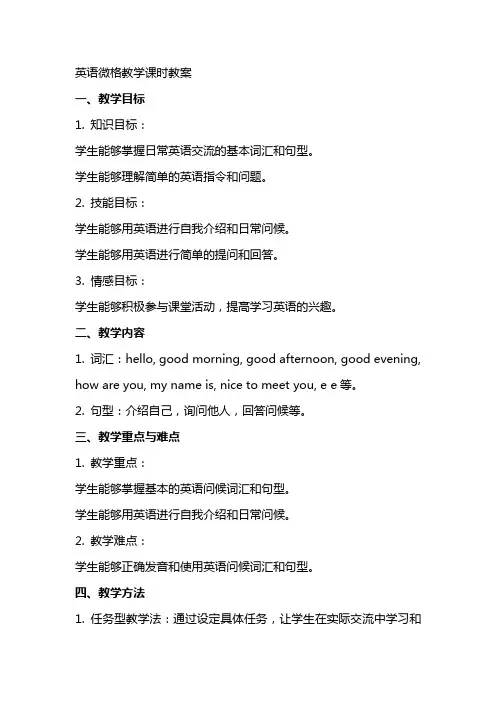
英语微格教学课时教案一、教学目标1. 知识目标:学生能够掌握日常英语交流的基本词汇和句型。
学生能够理解简单的英语指令和问题。
2. 技能目标:学生能够用英语进行自我介绍和日常问候。
学生能够用英语进行简单的提问和回答。
3. 情感目标:学生能够积极参与课堂活动,提高学习英语的兴趣。
二、教学内容1. 词汇:hello, good morning, good afternoon, good evening, how are you, my name is, nice to meet you, e e等。
2. 句型:介绍自己,询问他人,回答问候等。
三、教学重点与难点1. 教学重点:学生能够掌握基本的英语问候词汇和句型。
学生能够用英语进行自我介绍和日常问候。
2. 教学难点:学生能够正确发音和使用英语问候词汇和句型。
四、教学方法1. 任务型教学法:通过设定具体任务,让学生在实际交流中学习和使用英语。
2. 交际法:通过模拟真实场景,让学生在实际交流中掌握英语问候句型。
五、教学步骤1. 热身活动(5分钟):教师与学生用中文进行简单的自我介绍和问候。
教师引导学生用中文提问和回答。
2. 引入新知识(10分钟):教师展示英语问候词汇和句型,如“hello, good morning, how are you”等。
教师用中文解释这些词汇和句型的含义和用法。
3. 实践环节(10分钟):教师分组,让学生相互用英语进行自我介绍和问候。
教师巡回指导,纠正学生的发音和语法错误。
4. 总结与反馈(5分钟):教师邀请学生用中文总结所学内容。
教师对学生的表现进行评价和反馈。
5. 作业布置(5分钟):教师布置作业,要求学生复习所学的英语问候词汇和句型。
注意事项:在教学过程中,教师应注重学生的发音和语调,及时纠正错误。
教师应鼓励学生积极参与课堂活动,提高学习英语的兴趣。
教师应根据学生的实际情况,适当调整教学内容和难度。
六、教学评估1. 形成性评估:教师在课堂活动中观察学生的参与程度、发音准确性以及语法应用的正确性。
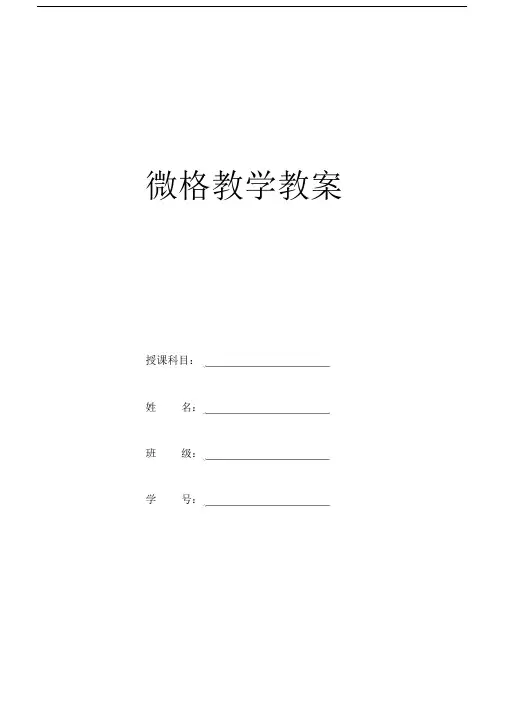
微格教学教案授课科目:姓名:班级:学号:教材课型训练技能教学目标教学方法及手段英语微格教学课时教案执教人:执教日期:人教版八年级上册课题What’s the matter?课时第一课时单词对话讲授教学时间10 分钟合作学习技能知识目标: 1. 学习完成任务所需要的语言:词汇: matter, cold, have a cold, stomachache, sore, back, arm,foot, feet, hand, head, leg, mouth, neck, nose, stomach, tooth,teeth, throat2. 句子准确表达身体的种种不适I have a headache /stomachache/ a toothache.I have a sore neck/a sore arm/ a sore throat/a cold/a fever询问他人身体状况What's the matter?3.完成课本第 7 页教学任务。
能力目标:能够正确描述身体各部位名称,准确表达身体的种种不适,询问他人身体状况情感目标:学会关心他人健康肢体动作与学生互动教学,学生之间互动加强记忆教学过程及内容教学过程教师活动学生活动教案设计说明时间分配T:Hey,boys andgirls! Are you fine?T: Oh! I am so glad tosee you all are soactive and so genetic.S: Yes!以生活事例情All of you are so景导入,调动学healthy. But I am very 1 分钟生上课激情,引sorry that I feel very出学习课题导入tired and there issomething wrong with myback.I may have abackache. Then how do weto ask about others ’health? That is what wewill learn today.Wewill learn a new unit:What’s the matter?( 板出 )T1: Weknow, the back isone part of our body. Sofirst, can you give me S1: headsome other names of the noseparts of body?face( 根据学生的作答及充throat板出一的 )teethT2:Follow me together arm由学生以旧to read these words.stomach引出新T3:OK. Now I ask, you neck,以学生中answer.foot心What ’ s this? ( 手依⋯次指着自己的身体部S2: 跟学位,学生作答 )S3:学生作答 4 分T3: And then we will usethese words to expressthe health problems与学生互( 板出相关元)合作学,加Follow me together.,活堂跟气氛Headache/backache/toothache/stomachache/ ⋯S4:猜T4: 用肢体言做出各种身体不适状,学生用所学做出猜S5: 完成T5:完成本第七1a部分,核答案T1:OK, good! Then howdo we ask aboutothers ’ health? It isour title: what’s thematter? (板 )How to response?I have a headache/跟句型学backache/toothache/引新stomachache/ ⋯( 板 ) 4 分答至熟T2:now ,please closeyour book. It’s pairwork time. You will bedivided into some groups. Every two of you will be one group.One asks, the other one answers to make up a dialogue with theexpressions we have学生互动,合作 learned. I will give学生自主编组对话互 学习,启发学生 you 5 minutes and then 动,熟练句型 主动思考,加深 one group of you will 印象act it out in front ofthe class.Time is up!学生上台表演点评Well done! I think you have been familiar with these expressions. And I hope that you willreview it after class.结 课What ’s more, I hope发出希望,及时 分钟all of you can learn to1复习,学以致用care about others.Asking he “ what ’ s the matter ” when we see someone is not feeling very well. Thank you!在本次授课中, 导入环节以身边的亲身事例开始, 与学生互动,授课内容主要采取合作学习的教学技能让学生在互动中学习词汇, 操练句型,已达到加深印教学反思 象,迅速有效的熟悉强化所学知识,并得以运用生活。
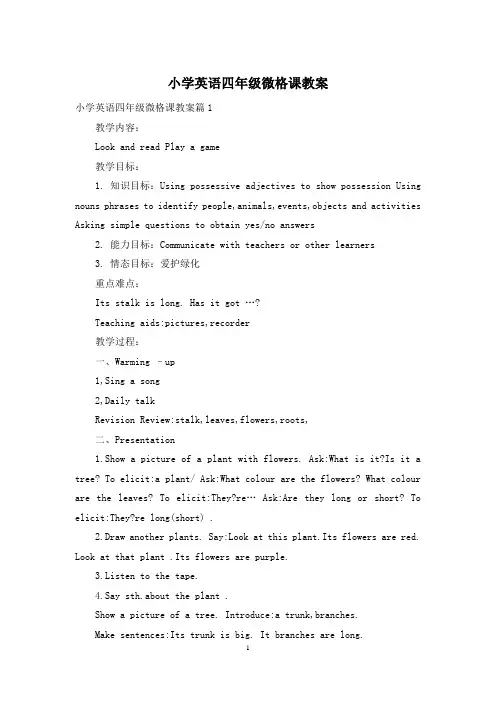
小学英语四年级微格课教案小学英语四年级微格课教案篇1教学内容:Look and read Play a game教学目标:1. 知识目标:Using possessive adjectives to show possession Using nouns phrases to identify people,animals,events,objects and activities Asking simple questions to obtain yes/no answers2. 能力目标:Communicate with teachers or other learners3. 情态目标:爱护绿化重点难点:Its stalk is long. Has it got …?Teaching aids:pictures,recorder教学过程:一、Warming –up1,Sing a song2,Daily talkRevision Review:stalk,leaves,flowers,roots,二、Presentation1.Show a picture of a plant with flowers. Ask:What is it?Is it a tree? To elicit:a plant/ Ask:What colour are the flowers? What colour are the leaves? To elicit:They?re… Ask:Are they long or short? To elicit:They?re long(short) .2.Draw another plants. Say:Look at this plant.Its flowers are red. Look at that plant .Its flowers are purple.3.Listen to the tape.4.Say sth.about the plant .Show a picture of a tree. Introduce:a trunk,branches.Make sentences:Its trunk is big. It branches are long.Listeen to the tape.Say sth about the tree.Play the cassette:Play a game/ Listen and repeat.Play this game.三、Consolidation1.Photocopiable pages 44-45.2.Workbook page ar practice book 4a page 35.板书设计:Unit 2 Loo k at,,, Its stalk is…Its trunk is…leaves are …branches… roots flowers小学英语四年级微格课教案篇2教学目标:(1)知识目标1.学习本文主要新单词:cry break monster2.学会运用核心句型Did you…?Yes, I did. / No, I didn’t.(2)能力目标1.了解使用一般过去时的一般疑问句。
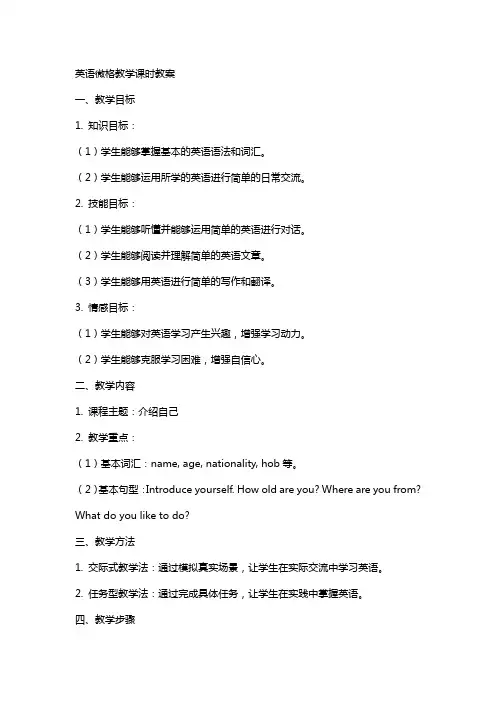
英语微格教学课时教案一、教学目标1. 知识目标:(1)学生能够掌握基本的英语语法和词汇。
(2)学生能够运用所学的英语进行简单的日常交流。
2. 技能目标:(1)学生能够听懂并能够运用简单的英语进行对话。
(2)学生能够阅读并理解简单的英语文章。
(3)学生能够用英语进行简单的写作和翻译。
3. 情感目标:(1)学生能够对英语学习产生兴趣,增强学习动力。
(2)学生能够克服学习困难,增强自信心。
二、教学内容1. 课程主题:介绍自己2. 教学重点:(1)基本词汇:name, age, nationality, hob等。
(2)基本句型:Introduce yourself. How old are you? Where are you from? What do you like to do?三、教学方法1. 交际式教学法:通过模拟真实场景,让学生在实际交流中学习英语。
2. 任务型教学法:通过完成具体任务,让学生在实践中掌握英语。
四、教学步骤1. 热身活动(5分钟)(1)教师与学生用中文进行简单的自我介绍。
(2)学生相互之间用中文进行自我介绍。
2. 引入主题(10分钟)(1)教师用英语进行自我介绍,展示基本词汇和句型。
(2)学生跟随教师一起模仿,重复基本词汇和句型。
3. 实践环节(15分钟)(1)学生分成小组,用英语进行自我介绍。
(2)教师巡回指导,纠正学生的发音和语法错误。
4. 总结与反馈(5分钟)(1)教师对学生的表现进行点评,给予鼓励和指导。
(2)学生分享学习心得和感受。
五、课后作业1. 复习本节课所学的词汇和句型。
2. 准备下一节课的主题和相关词汇。
六、教学评估1. 课堂观察:教师将对学生在课堂上的参与度、发音、语法运用和交流能力进行观察和评估。
2. 小组活动评估:教师将对学生在小组活动中的表现进行评估,包括语法准确性、沟通流畅性和合作态度。
3. 课后作业检查:教师将检查学生的课后作业,以评估学生对课堂内容的理解和掌握程度。
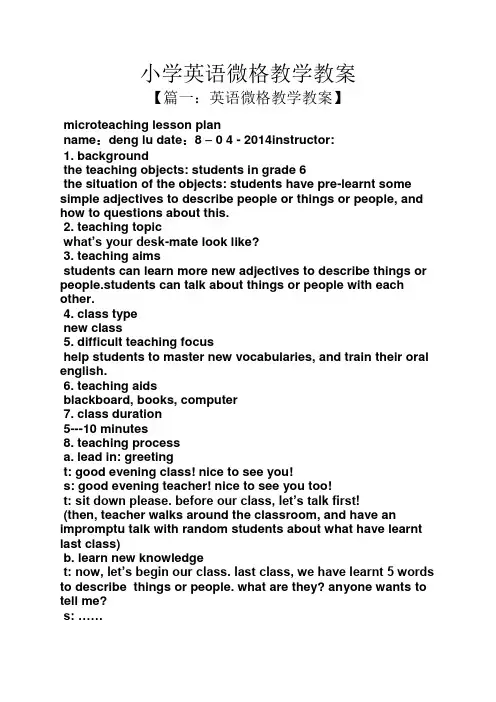
小学英语微格教学教案【篇一:英语微格教学教案】microteaching lesson planname:deng lu date:8 – 0 4 - 2014instructor:1. backgroundthe teaching objects: students in grade 6the situation of the objects: students have pre-learnt some simple adjectives to describe people or things or people, and how to questions about this.2. teaching topicwhat’s your desk-mate look like?3. teaching aimsstudents can learn more new adjectives to describe things or people.students can talk about things or people with each other.4. class typenew class5. difficult teaching focushelp students to master new vocabularies, and train their oral english.6. teaching aidsblackboard, books, computer7. class duration5---10 minutes8. teaching processa. lead in: greetingt: good evening class! nice to see you!s: good evening teacher! nice to see you too!t: sit down please. before our class, let’s talk first!(then, teacher walks around the classroom, and have an impromptu talk with random students about what have learnt last class)b. learn new knowledget: now, let’s begin our class. last class, we have learnt 5 words to describe things or people. what are they? anyone wants to tell me?s: ……t: ok, you are all excellent. this class we are going to learn another 5 new words.(write on the blackboard: shy, outgoing , humorous, handsome, careless )t: first, please those wordsafter me. i read one time, and i want you to read three times, ok? s: ok(then teach students to read these words, and work out their meaning. ask students to read those words by themselves )c. consolidation and practicet: we have learnt these words, now, let’s do some exercise to check up. d: conclusiont: today, we have learnt 5 new words, what are they?s: ……t: all of you have done a good job! today’s homework is towrite a composition about your classmate. that’s all, thank you 【篇二:新概念第二册四十四课微格教学教案】an example of mini-lesson teaching planteaching materials:new concept english 2, lesson 44.teaching objectives:1. practicing students’ concentration on some reading materials.2. learning some new words and phrases.main teaching skills to be trained:1. organizing skills2. ending skillteaching aids.teaching procedures:step i pre-learning (2’)forest.(teaching skills: organizing skills, beginning the class.)before we reading the passage, let’s learn the new words first. please look at the blackboard, read after me. (teaching skills: organizing skills, prediction: the teacher can repeat somewords more times if they are difficult to students.). thestudents read the words after teacher.● forestn. 森林 risk n. 危险,冒险● picnicn. 野餐 possession n. 所有2. t: well, here i will give you three minutes to read this passage. read it carefully and then iwill ask you some questions with your books closed. now please focus on it.step ii questioning and answering (5’ in reality, now just using directions)1. t: that’s an interesting story, isn’t it? have you finished it? ok, here is the first question:what did the two men do when mrs. sterling was having a picnic with her children at the edge of the forest?2. s1: (raising up hands and standing) the two men had rushed up to her and tried to steal herhandbag.3. t: very good, sit down please. now, the second question: what were the two thieves doingwhen mrs. sterling caught up with them? ok, you please.4. s2: they were going through the contents of her bag.5. t: good job! well, who can answer the last question? what did the thieves do when mrs.sterling ran straight at him?6. s3: they dropped the bag and ran away.step iii phrase learning (5’)1. t: everybody seemed to do a good job! now open the book to lesson 44 and underline thephrases which you think are important.(teaching skills: announcing the teaching plan.)then i will explain all of them to you.2. t: have you finished? well, let me see. (the teacher walks around the classroom to see thestudents’ underlined phrases.) ok, let’s look at the blackboard, here are all the phrases you think is important and difficult to you. all of you should take notes on your textbook. let’s go through it!1) rush up to sb. 迎面冲向某人she rushed up to a man in such a hurry. 2) at the edge of 在……的边上the park lies at the edge of the town. 3) in ones possession = in the possession of sb. 为某人所拥有……the house used to be in my possession, but now it is in the possession of an old lady.3. when explain the phrases, let the students translate the example sentences to make sure thatthe students grasp the new phrases well.step iv homework and project (3’)1. t: summing up (teaching skills: ending skill): ok, boys and girls! i’m very glad to see thatyou performed so well today. all of you were enjoy the passage, weren’t you? after class, you can prepare a short play in group according to this passage. i think it must be a lot of fun to present the act in next class.2. t: also all of you should review the new words and phrases.i will give you a dictation nexttime.3. t: ok, class is over! goodbye boys and girls, see you next time!4. ss: goodbye, miss jiang!november 1st, 2014【篇三:小学英语微格教学:现在进行时】复习现在进行时的含义与构成1.含义:表示现在正在进行或一段时间正在进行的动作标志词:now, look, listen等。
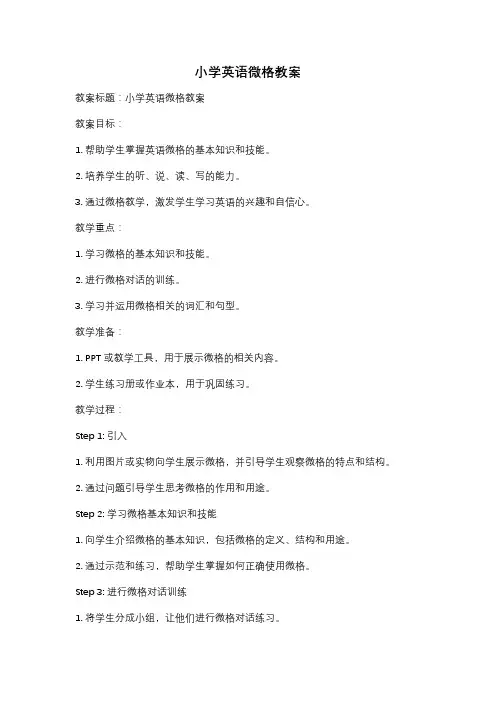
小学英语微格教案教案标题:小学英语微格教案教案目标:1. 帮助学生掌握英语微格的基本知识和技能。
2. 培养学生的听、说、读、写的能力。
3. 通过微格教学,激发学生学习英语的兴趣和自信心。
教学重点:1. 学习微格的基本知识和技能。
2. 进行微格对话的训练。
3. 学习并运用微格相关的词汇和句型。
教学准备:1. PPT或教学工具,用于展示微格的相关内容。
2. 学生练习册或作业本,用于巩固练习。
教学过程:Step 1: 引入1. 利用图片或实物向学生展示微格,并引导学生观察微格的特点和结构。
2. 通过问题引导学生思考微格的作用和用途。
Step 2: 学习微格基本知识和技能1. 向学生介绍微格的基本知识,包括微格的定义、结构和用途。
2. 通过示范和练习,帮助学生掌握如何正确使用微格。
Step 3: 进行微格对话训练1. 将学生分成小组,让他们进行微格对话练习。
2. 提供一些常见的对话情景,让学生运用微格进行对话练习。
3. 鼓励学生积极参与,互相交流和纠正对方的错误。
Step 4: 学习并运用微格相关的词汇和句型1. 向学生介绍一些与微格相关的常用词汇和句型。
2. 通过示范和练习,帮助学生掌握如何正确运用这些词汇和句型。
Step 5: 巩固练习1. 分发学生练习册或作业本,让学生完成相关的练习题。
2. 在学生完成后,进行答案讲解和讨论。
Step 6: 总结和反馈1. 对本节课的内容进行总结,强调学生学到的知识和技能。
2. 鼓励学生提出问题或反馈意见,以便改进教学。
教学延伸:1. 鼓励学生在日常生活中运用微格进行英语对话练习。
2. 提供更多的微格对话练习材料,以帮助学生进一步巩固所学内容。
教学评估:1. 观察学生在课堂上的积极参与和表现。
2. 收集学生完成的练习册或作业本,检查他们对微格的掌握程度。
3. 进行口头评估,让学生展示他们运用微格进行对话的能力。
教学反思:在教学过程中,教师应该根据学生的实际情况和学习进度,适时调整教学方法和内容。

英语微格教学课时教案一、教学目标1. 知识目标:(1)学生能够掌握日常英语交流的基本词汇和句型。
(2)学生能够理解和运用所学的语法知识。
(3)学生能够通过听力、口语、阅读和写作等多种方式运用英语。
2. 技能目标:(1)学生能够熟练地运用英语进行日常交流。
(2)学生能够独立完成英语听、说、读、写各项任务。
(3)学生能够运用所学的英语知识解决实际问题。
3. 情感目标:(1)激发学生学习英语的兴趣和积极性。
(2)培养学生的自信心,使他们相信自己能够学好英语。
(3)培养学生的合作精神,使他们能够在团队中有效地沟通和协作。
二、教学内容1. 词汇:本节课将学习与日常生活相关的词汇,如:greetings、introduction、family、work等。
2. 句型:学生将学习如何用英语进行自我介绍、询问他人信息以及表达自己的喜好等基本句型。
3. 语法:本节课将介绍现在时态的基本用法,学生将学会如何用英语描述自己的日常生活。
三、教学过程1. 导入:教师通过与学生进行简单的英语问候,引起学生的兴趣,并引入本节课的主题。
2. 新课内容:教师讲解本节课的词汇、句型和语法知识,通过示例和练习帮助学生理解和掌握。
3. 实践环节:学生分组进行角色扮演,运用所学的词汇和句型进行英语对话,教师巡回指导并提供反馈。
4. 巩固环节:教师组织学生进行小组活动,完成相关的听力、口语、阅读和写作任务,巩固所学的知识。
四、教学评价1. 课堂参与度:观察学生在课堂上的积极参与程度,包括发言、回答问题、参与讨论等。
2. 作业完成情况:检查学生完成作业的质量,包括词汇记忆、句型练习、语法应用等。
3. 小组活动表现:评价学生在小组活动中的合作能力和英语运用水平,包括对话流畅度、任务完成情况等。
五、教学资源1. 教材:使用英语教材,提供词汇、句型和语法知识的学习材料。
2. 多媒体教具:利用多媒体课件、图片、视频等辅助教学,增加课堂趣味性。
3. 练习册:提供相关的听力、口语、阅读和写作练习,帮助学生巩固所学知识。
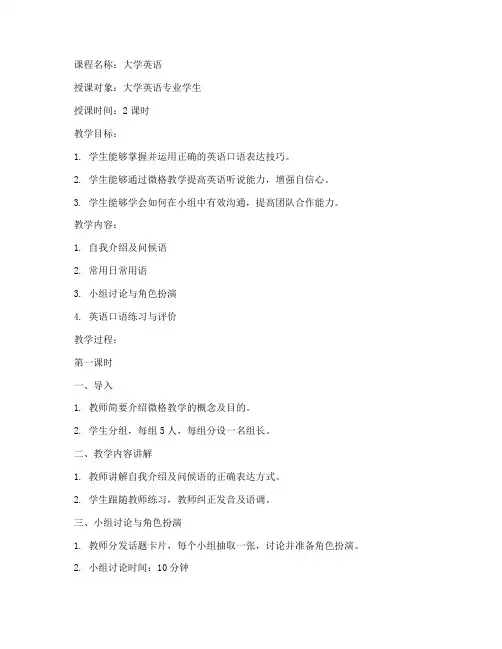
课程名称:大学英语授课对象:大学英语专业学生授课时间:2课时教学目标:1. 学生能够掌握并运用正确的英语口语表达技巧。
2. 学生能够通过微格教学提高英语听说能力,增强自信心。
3. 学生能够学会如何在小组中有效沟通,提高团队合作能力。
教学内容:1. 自我介绍及问候语2. 常用日常用语3. 小组讨论与角色扮演4. 英语口语练习与评价教学过程:第一课时一、导入1. 教师简要介绍微格教学的概念及目的。
2. 学生分组,每组5人,每组分设一名组长。
二、教学内容讲解1. 教师讲解自我介绍及问候语的正确表达方式。
2. 学生跟随教师练习,教师纠正发音及语调。
三、小组讨论与角色扮演1. 教师分发话题卡片,每个小组抽取一张,讨论并准备角色扮演。
2. 小组讨论时间:10分钟3. 角色扮演时间:5分钟四、英语口语练习与评价1. 学生进行口语练习,教师观察并记录。
2. 学生之间互相评价,指出优点及需改进之处。
3. 教师总结本次练习的亮点及不足,提出改进建议。
第二课时一、复习与巩固1. 教师带领学生复习第一课时所学内容。
2. 学生进行自我介绍及问候语的练习。
二、小组讨论与角色扮演1. 学生分组进行角色扮演,内容与第一课时相同。
2. 小组讨论时间:10分钟3. 角色扮演时间:5分钟三、英语口语练习与评价1. 学生进行口语练习,教师观察并记录。
2. 学生之间互相评价,指出优点及需改进之处。
3. 教师总结本次练习的亮点及不足,提出改进建议。
四、总结与反思1. 教师引导学生进行总结,分享学习心得。
2. 学生反思自己在微格教学中的表现,提出改进措施。
教学评价:1. 学生在微格教学中的表现,包括口语表达、小组合作等方面。
2. 学生对微格教学方法的反馈,包括满意度、收获等。
3. 教师对学生的评价,包括学习态度、进步程度等。
教学资源:1. 英语口语教材2. 角色扮演话题卡片3. 录音设备教学反思:1. 教师应关注学生在微格教学中的心理状态,营造轻松愉快的氛围。
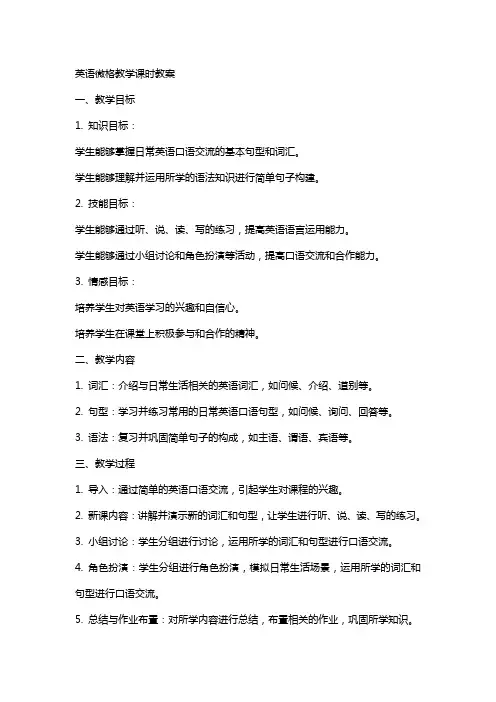
英语微格教学课时教案一、教学目标1. 知识目标:学生能够掌握日常英语口语交流的基本句型和词汇。
学生能够理解并运用所学的语法知识进行简单句子构建。
2. 技能目标:学生能够通过听、说、读、写的练习,提高英语语言运用能力。
学生能够通过小组讨论和角色扮演等活动,提高口语交流和合作能力。
3. 情感目标:培养学生对英语学习的兴趣和自信心。
培养学生在课堂上积极参与和合作的精神。
二、教学内容1. 词汇:介绍与日常生活相关的英语词汇,如问候、介绍、道别等。
2. 句型:学习并练习常用的日常英语口语句型,如问候、询问、回答等。
3. 语法:复习并巩固简单句子的构成,如主语、谓语、宾语等。
三、教学过程1. 导入:通过简单的英语口语交流,引起学生对课程的兴趣。
2. 新课内容:讲解并演示新的词汇和句型,让学生进行听、说、读、写的练习。
3. 小组讨论:学生分组进行讨论,运用所学的词汇和句型进行口语交流。
4. 角色扮演:学生分组进行角色扮演,模拟日常生活场景,运用所学的词汇和句型进行口语交流。
5. 总结与作业布置:对所学内容进行总结,布置相关的作业,巩固所学知识。
四、教学资源1. 教学PPT:包含词汇、句型和语法的内容,以及相关的图片和例句。
2. 录音机或音响设备:用于播放英语口语交流的录音,帮助学生进行听力和模仿练习。
3. 作业本:用于布置和收集学生的作业。
五、教学评价1. 课堂参与度:观察学生在课堂上的积极参与和合作情况。
2. 口语交流能力:评估学生在角色扮演和小组讨论中的口语交流能力。
3. 作业完成情况:检查学生完成作业的情况,巩固所学知识。
六、教学策略1. 交际式教学法:通过模拟真实场景,鼓励学生积极参与,提高口语交流能力。
2. 任务型教学法:通过小组合作完成任务,培养学生的团队合作精神。
3. 情境教学法:创设真实情境,让学生在实际语境中学习和应用英语。
七、教学注意事项1. 关注学生的个体差异,因材施教,使每个学生都能在课堂上得到锻炼和提高。
#### 教学目标1. 知识目标:学生能够掌握特定词汇或句型,并能应用于实际情境中。
2. 技能目标:学生能够通过听、说、读、写等手段,提高英语运用能力。
3. 情感目标:激发学生对英语学习的兴趣,培养良好的学习习惯。
#### 教学内容- 词汇/句型:选择一个或几个词汇或句型进行教学。
- 教材/资源:教材中的相关章节或课外资源。
#### 教学重点- 重点词汇或句型的正确使用。
- 语境中词汇或句型的实际运用。
#### 教学难点- 词汇或句型的正确发音和拼写。
- 在复杂语境中运用词汇或句型。
#### 教学过程一、导入(Warming Up)1. 时间:1分钟2. 活动:播放一首简单的英文歌曲或进行简短的英语游戏,以活跃课堂气氛,集中学生注意力。
二、呈现(Presentation)1. 时间:2分钟2. 活动:- 教师展示相关图片或实物,引入新词汇或句型。
- 通过PPT或黑板,呈现词汇或句型的拼写和发音。
三、练习(Practice)1. 时间:4分钟2. 活动:- 听音模仿:播放音频,学生跟读词汇或句型。
- 小组活动:学生分组,进行词汇或句型的实际运用练习。
- 角色扮演:学生扮演不同角色,进行情景对话练习。
四、巩固(Consolidation)1. 时间:2分钟2. 活动:- 个人展示:请个别学生上台展示所学内容。
- 课堂小结:教师简要回顾本节课所学内容,强调重点和难点。
五、作业(Homework)1. 时间:1分钟2. 活动:- 布置课后练习,如抄写词汇、造句或观看相关英语视频。
#### 教学评价- 课堂表现:观察学生在课堂上的参与度、积极性和互动情况。
- 作业完成情况:检查学生的课后作业,了解学生对知识的掌握程度。
#### 教学反思- 教师在课后应反思教学过程,总结教学中的成功之处和不足,以便改进教学方法。
#### 教学案例案例:以PEP小学英语三年级为例,教学目标为掌握“eye, face, ear, nose, mouth”等身体部位的单词。
英语微格教学课时教案一、教学目标1. 知识目标:(1)学生能够掌握基本的英语语法和词汇。
(2)学生能够运用所学的英语进行简单的日常交流。
(3)学生能够理解简单的英语文章,并能够进行阅读理解。
2. 技能目标:(1)学生能够准确地发音,流畅地朗读英语。
(2)学生能够运用所学的英语进行听、说、读、写的实际操作。
(3)学生能够运用所学的英语进行有效的沟通和交流。
3. 情感目标:(1)激发学生学习英语的兴趣和热情。
(2)培养学生的自信心,让他们相信自己能够学好英语。
(3)培养学生的合作精神,让他们能够与同学一起学习,共同进步。
二、教学内容1. 教学主题:介绍自己和家人。
2. 教学重点:运用英语介绍自己和家人的名称、年龄、职业等。
3. 教学难点:正确运用英语语法和词汇进行介绍。
三、教学过程1. 热身活动(5分钟):(1)让学生自由交谈,询问他们是否喜欢英语学习。
(2)引导学生谈论一下自己的家庭成员和他们的特点。
2. 引入新课(10分钟):(1)向学生介绍本节课的主题:介绍自己和家人。
(2)展示一些与家庭成员相关的图片,让学生猜测他们的关系。
3. 讲解和示范(10分钟):(1)讲解如何用英语介绍自己和家人的名称、年龄、职业等。
(2)示范如何用英语进行自我介绍和介绍家人。
4. 实践环节(10分钟):(1)让学生分成小组,用英语进行自我介绍和介绍家人。
(2)鼓励学生大胆开口,注重语音语调的准确性。
5. 巩固环节(5分钟):(1)让学生在班级内进行角色扮演,模拟真实场景进行自我介绍和介绍家人。
(2)邀请部分学生到讲台前进行表演,给予表扬和鼓励。
四、作业布置1. 让学生用英语写一篇关于自己和家人的介绍短文。
2. 让学生复习本节课所学的词汇和语法,准备下一节课的测试。
五、教学反思2. 对教学方法和教学内容进行反思,看是否需要进行调整。
3. 思考如何激发学生的学习兴趣,提高他们的学习积极性。
六、教学评估1. 课堂观察:观察学生在课堂上的参与程度、发音准确性以及语言流畅性。
英语微格教学课程设计一、课程目标知识目标:1. 学生能够掌握并运用本单元的新词汇和短语,如“introduce”, “describe”, “characteristic”等;2. 学生能够理解和运用一般现在时和一般过去时的正确语法结构;3. 学生能够理解并运用课文中的重点句型和常用表达,如“there be”句型,描述地点、人物和物品的特点。
技能目标:1. 学生能够通过小组合作,进行有效沟通,完成介绍和描述的任务;2. 学生能够运用所学知识,独立完成一篇介绍人物或地点的小短文;3. 学生能够运用听说读写技能,参与课堂活动,提高英语综合运用能力。
情感态度价值观目标:1. 学生能够增强对英语学习的兴趣,树立自信心,积极参与课堂活动;2. 学生能够学会尊重他人,善于倾听和表达,培养良好的团队协作精神;3. 学生能够了解并尊重不同文化背景,拓宽国际视野,培养跨文化交际意识。
本课程针对的是小学高年级学生,他们在认知和语言能力上有了较好的基础。
课程设计充分考虑学生的年龄特点,注重培养学生的学习兴趣和实际运用能力。
在教学过程中,教师将关注学生的个体差异,提供个性化的指导,确保课程目标的实现。
通过本课程的学习,学生将能够达到以上设定的知识、技能和情感态度价值观目标,为今后的英语学习打下坚实基础。
本节课以英语课本第五单元“Introducing Myself”为教学内容,围绕人物介绍展开,主要包括以下章节:1. 新词汇和短语学习:introduce, describe, family, hobby, characteristic, like, love, enjoy等;- 教学安排:通过图片、情景和例句展示新词汇,让学生在实际语境中理解和运用。
2. 语法知识:一般现在时和一般过去时的运用;- 教学安排:通过对比和练习,让学生掌握两种时态的用法,并能运用到实际对话和小短文中。
3. 句型和表达:there be句型,描述人物和地点的特点;- 教学安排:结合课文和实际情景,让学生学会使用句型和表达,进行人物和地点的描述。
英语微格教学课时教案一、教学目标1. 知识目标:让学生掌握基本的英语语法、词汇和句型。
2. 能力目标:提高学生的英语口语表达能力和听力理解能力。
二、教学内容1. 词汇:常见的日常词汇,如问候、介绍、道别等。
2. 语法:基本句型结构,如主谓宾、主系表等。
3. 句型:日常交流中的常用句型,如询问时间、地点、喜好等。
三、教学重点与难点1. 重点:词汇的掌握和运用,基本句型的构建。
2. 难点:语法知识的运用,口语表达的流畅性。
四、教学方法1. 任务型教学法:通过设定具体任务,让学生在完成任务的过程中练习英语。
2. 交际法:模拟真实场景,让学生在实际交流中提高英语水平。
五、教学步骤1. 热身活动(5分钟):教师与学生用中文进行简单的问候,引入英语问候的话题。
2. 新课导入(10分钟):教师介绍本节课的词汇和语法知识,通过示例让学生理解并掌握。
3. 课堂实践(15分钟):学生分组进行角色扮演,运用所学词汇和句型进行交流。
4. 听力练习(10分钟):教师播放英语对话或短文,学生进行听力理解,回答相关问题。
5. 总结与作业布置(5分钟):教师对本节课的内容进行总结,布置作业,鼓励学生复习巩固所学知识。
六、教学评价1. 评价方式:课堂表现、作业完成情况、听力测试成绩。
2. 评价标准:学生能够流利地使用所学词汇和句型进行交流,作业正确率达到要求,听力测试成绩良好。
七、教学资源1. 教材:英语微格教学教材。
2. 辅助材料:单词卡片、听力材料、角色扮演道具等。
八、教学进度安排1. 第1周:基本问候和介绍。
2. 第2周:询问时间和地点。
3. 第3周:表达喜好和兴趣。
4. 第4周:谈论日常活动。
5. 第5周:复习和总结。
九、教学反思1. 教师需要在课后对教学效果进行反思,总结教学中的优点和不足。
2. 根据学生的反馈和学习情况,调整教学方法和进度。
十、拓展活动1. 组织英语角活动,让学生在轻松的氛围中练习英语。
2. 开展英语演讲比赛,提高学生的英语表达能力。
一、课程名称初中英语微格课二、教学目标1. 通过微格课,帮助学生巩固和复习已学英语知识,提高英语实际应用能力。
2. 培养学生的英语听说能力,提高学生的口语表达流利度。
3. 增强学生对英语学习的兴趣,激发学生的学习积极性。
三、教学内容1. 主题:根据实际教学需要,选取适合的英语话题。
2. 教学材料:教材、图片、音频、视频等。
四、教学过程(一)导入(5分钟)1. 利用图片、音频或视频导入主题,激发学生的学习兴趣。
2. 简要介绍本次微格课的学习目标。
(二)热身活动(10分钟)1. 进行简单的英语歌曲或游戏,活跃课堂气氛。
2. 引导学生进行英语口语练习,为接下来的教学环节做准备。
(三)主体教学(25分钟)1. 阅读教材,引导学生关注重点词汇和句型。
2. 分析课文内容,讲解重点语法知识。
3. 进行听力练习,提高学生的听力水平。
4. 分组讨论,让学生运用所学知识进行交流。
5. 角色扮演,锻炼学生的口语表达能力。
(四)巩固练习(10分钟)1. 进行课后练习,巩固所学知识。
2. 教师巡回指导,解答学生在练习过程中遇到的问题。
(五)总结与反馈(5分钟)1. 对本次微格课进行总结,强调重点知识。
2. 鼓励学生在课后继续复习巩固。
3. 收集学生对本次微格课的反馈意见,为今后的教学提供参考。
五、教学评价1. 课堂参与度:观察学生在课堂上的表现,如是否积极参与、回答问题等。
2. 口语表达能力:评估学生在角色扮演和小组讨论中的口语表达流利度。
3. 作业完成情况:检查学生课后练习的完成情况。
六、教学反思1. 教师应根据学生的实际情况,调整教学内容和教学方法。
2. 注重培养学生的英语实际应用能力,提高学生的英语综合素质。
3. 加强与学生之间的互动,关注学生的学习需求,提高教学效果。
七、教学资源1. 教材:初中英语教材2. 图片、音频、视频:与教学内容相关的素材3. 课后练习:课后巩固练习题八、教学时间1. 微格课总时长:40分钟2. 各环节时间分配:导入(5分钟)、热身活动(10分钟)、主体教学(25分钟)、巩固练习(10分钟)、总结与反馈(5分钟)以上为初中英语微格课教案模板,教师可根据实际教学情况进行调整和优化。
课时:1课时年级:八年级教材:《英语课程标准》教学目标:1. 学生能够正确朗读并理解单词:book, school, teacher, student。
2. 学生能够运用所学单词进行简单的对话。
3. 培养学生的听说能力,提高英语学习的兴趣。
教学重点:1. 正确朗读单词。
2. 理解单词的含义。
3. 进行简单的对话。
教学难点:1. 单词的正确发音。
2. 对话中的语法运用。
教学准备:1. 多媒体课件(包含单词图片、例句等)。
2. 教学卡片(单词卡片)。
3. 课堂练习册。
教学过程:一、导入(1分钟)1. 教师与学生用英语进行简单的问候。
2. 引导学生回忆已学过的单词,如:hello, good morning, thank you等。
二、单词学习(3分钟)1. 教师展示单词卡片,引导学生朗读并理解单词的含义。
2. 学生跟读,教师纠正发音。
3. 教师播放例句,学生跟读并理解例句的意思。
三、对话练习(3分钟)1. 教师展示对话情景,引导学生运用所学单词进行对话。
2. 学生分组练习,教师巡视指导。
3. 学生展示对话,教师点评并纠正错误。
四、课堂练习(2分钟)1. 教师发放课堂练习册,学生独立完成练习。
2. 教师巡视指导,解答学生疑问。
五、总结(1分钟)1. 教师引导学生回顾本节课所学内容。
2. 学生用英语总结所学单词和对话。
教学反思:本节课通过微格教学,使学生在短时间内掌握了单词和对话,提高了英语学习的兴趣。
在教学过程中,教师要注意以下几点:1. 注重学生的发音,及时纠正错误。
2. 创设真实的语言环境,提高学生的听说能力。
3. 鼓励学生积极参与课堂活动,提高课堂氛围。
4. 及时总结教学效果,调整教学策略。
教学评价:1. 学生能够正确朗读并理解单词:book, school, teacher, student。
2. 学生能够运用所学单词进行简单的对话。
3. 学生在课堂上的参与度较高,学习兴趣浓厚。
备注:1. 教师可根据实际情况调整教学内容和教学时间。